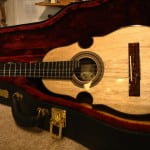 The cuatro—also the word for “four” in Spanish—was originally a four-stringed instrument roughly fashioned in the mountains and hills of Puerto Rico by the Taíno natives, European misfits, and runaway slaves who escaped to the interior beginning in the 16th century to get away from the Spanish colonists at the coasts. These peoples became the social class in Puerto Rico called the jíbaros, who lend their name even today to the style of music they produced.
The cuatro—also the word for “four” in Spanish—was originally a four-stringed instrument roughly fashioned in the mountains and hills of Puerto Rico by the Taíno natives, European misfits, and runaway slaves who escaped to the interior beginning in the 16th century to get away from the Spanish colonists at the coasts. These peoples became the social class in Puerto Rico called the jíbaros, who lend their name even today to the style of music they produced.
As the three separate cultures of the jíbaros combined over the years, the Spanish necessity of stringed instruments to perform the Catholic mass remained. The cuatro and other supporting instruments were made to meet this necessity. Traditionally, the cuatro is carved out of a single piece of wood, as this was the only method to produce them in the hills of Puerto Rico. Their original four-strings mimicked the Spanish instruments at the time, and they were tuned identically. The cuatro, however, also found its role outside of the mass in the form of décimas and other strict verse forms. It was used to play the melody backing a traditional troubadour’s singing in a musical ensemble.
As Puerto Rico moved into the 19th century, the jíbaros started to integrate into the Spanish society that had flourished and the towns that were popping up. With the intermixing of these cultures, the jíbaros started to hear the new Spanish sounds of classical guitars and other popular instruments which had gained more strings. Eventually this was translated into the cuatro form we know today with five pairs of ten metal strings, tuned to the same intervals as the classical Spanish guitars that were popular in the 1800s.
